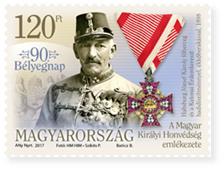
90. Bélyegnap - Bélyeg
A Magyar Posta kétcímletű alkalmi bélyegsorozat és feláras bélyegblokk kibocsátásával köszönti a hazai bélyeggyűjtők legnagyobb ünnepét, a Bélyegnapot, mely eseménysorozatra 2017. november 3. és 5. között a budapesti Stefánia Palotában kerül sor. Az újdonságok Baticz Barnabás grafikusművész tervei szerint az ANY Biztonsági Nyomda Nyrt.-ben készültek. A kétcímletű bélyegsor, a bélyegblokk és az első napi borítékok november 3-tól vásárolhatók meg.
Az 1867. évi osztrák–magyar kiegyezés nyomán az 1868:XLI. törvénycikk rendelkezett a Magyar Királyi Honvédség felállításáról, amely kezdetben gyalogságból és lovasságból, majd 1913-tól tüzérségből is állt. Első főparancsnoka Habsburg–Lotaringiai József Károly Lajos (1833–1905) főherceg, lovassági tábornok volt, aki az 1866-os porosz–osztrák háborúban szerzett érdemeiért a Katonai Érdemkereszt hadi díszítménnyel kitüntetésben részesült, 1898-tól pedig az érdemjel ékkövekkel berakott, különleges változatát viselhette. Az értékes kitüntetést és viselőjét a 120 forint névértékű bélyeg ábrázolja.
A 155 forint névértékű bélyegen a honvéd lovasság két jellegzetes tárgyi emléke látható. Az osztrák–magyar közös hadsereg 1869 M csákóját a Magyar Királyi Honvédség is átvette. A honvéd csákókat a csákócímer (a képen az 1891-es változat), a fehér lószőrforgó, illetve az arany zsinórok és paszományok meggyvörös beszövése különböztette meg a közös hadseregéitől. Az egyes huszárezredeket a csákók eltérő színe mellett a fejfedő bal oldalán elhelyezett ezredszám jelölte. A bemutatott csákó felső pereménél körbefutó paszomány hadnagyi–főhadnagyi rendfokozatra utal. Az 1904 M lovastiszti szablyát az osztrák–magyar haderő lovas, illetve lovasított (például tüzér) alakulatainak tisztjei számára rendszeresítették.
Az 500+300 Ft névértékű, feláras, sorszámozott blokkon a Stefánia Palota homlokzatai és belső terei tekinthetők meg. Az 1895-ben Park-Club néven megnyitott épület létrejöttének fő célja a nemesség társasági összejöveteleinek biztosítása volt. Az egyemeletes ingatlan magas és tágas belső terekkel, széles erkélyekkel, tágas lépcsőkkel, a kor főúri ízlésének mindenben megfelelő elrendezésben épült meg neobarokk stílusban. A második világháborúban megsérült létesítmény teljes rekonstrukciójára 1965-ben került sor, melynek során új neobarokk berendezés került az épületbe. Hivatalos elnevezése 1993 óta Stefánia Palota, fő feladata, hogy reprezentatív helyszínt biztosítson a Honvédelmi Minisztérium és a Magyar Honvédség rendezvényeinek.
A bélyegsor elsőnapi borítékján az 1869 M honvéd gyalogsági csapatzászló stilizált ábrázolása látható, a blokk elsőnapi borítékját a Stefánia Palota főhomlokzata díszíti.










